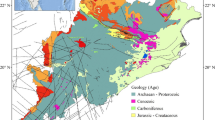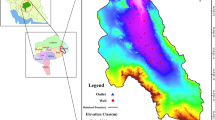Abstract
Groundwater inrushes often occur in the coal mines of China. One of the water sources is the aquifers underlying the coal seams. Because such a water hazard is affected by many factors, data collected from various sources need to be evaluated to predict its occurrence. This paper introduces an innovative approach in which the water inrush risk is represented by the vulnerability index. This method combines the geographic information system and the artificial neural network. The artificial neural network is used to estimate the weight of each factor. Unlike the traditional prediction method in which two controlling factors are often evaluated without regard to their relative importance, this new approach incorporates multi-factors and describes the non-linear dynamical processes.




Similar content being viewed by others
References
Bonham CGF, Agterberg FP (1990) Weights of evidence: a new approach to mapping mineral potential. Statistical applications in the earth sciences. Geological Survey of Canada, Canada, pp 231–245
Duan S (2003) Probe into the calculation formula of coefficient of water bursting from coal seam floor. Hydrogeol Eng Geol (1):96–99
Fang P, Wei Z, Liao Z (1996) Specialized hydrogeology. Geological Press, Beijing
Goldscheider N (2005) Karst groundwater vulnerability mapping: application of a new method in the Swabian Alb, Germany. Hydrogeol J 13(4):555–564
Gui H, Sun B (2005) Study meaning and the core content of the control theory about water inrush from bed bottom in deep mining. J Anhui Univ Sci Technol (Natural Science) 19(3):1–4
Hu C, Zhou Y (2005) Information integrated service review and prospect. Library Tribune (4):1–6
Karimi H, Raeisi E, Bakalowicz M (2005) Characterizing the main karst aquifers of the Alvand basin, northwest of Zagros, Iran, by a hydrogeochemical approach. Hydrogeol J 13(5–6):787–799
Klimchouk AB, Aksem SD (2005) Hydrochemistry and solution rates in gypsum karst: case study from the Western Ukraine. Environ Geol 48(3):307–319
Li J (2000) The relations of in-situ rock stress and water-resisting ability for floor aquifuge. Coal Geol Explor 28(4):47–49
Li J, Lian C, Guo W (1995) Depth of broken floor rock when the thick seam is repeated coal-mining. Coal Geol Explor 23(4):43–44
Li X, Tang H, Chen S (2005) Application of logistic regression based on GIS to the evaluation of the regional slope stability. Highway Traffic Sci Technol pp 152–155
Ohlmacher GC, Davis JC (2003) Using multiple logistic regression and GIS technology to predict landslide hazard in Northeast Kansas, USA. Eng Geol (69):331–343
Panagopoulos G, Lambrakis N, Katagas C, Papoulis D, Tsolis-Katagas P (2005) Water–rock interaction induced by contaminated groundwater in a karst aquifer, Greece. Environ Geol 49(2):300–313
Shepherd IDH (1991) Information integration and GIS in Geographical Information Systems. In: Maguire DJ, Goodchild MF, Rhind DW (eds) Principles and application, vol 2. Longman, London, pp 337–360
Shi H (1993) Neural network and its application. Xi’an University of Electronic Technology Press (in Chinese), Xi’an
Su H, Ge Y, Liu D (1999) A GIS-based mineral deposits prediction system by using evidence weight modeling. Geol Prospect pp 44–46
Tao Z, Tang F, Zhang L (1992) Joint and fault of the rock mechanics. China Geology University Press, Wuhan
Wang L (2001) The theory and algorithm of analytic network process. Syst Eng Theor Pract 21(3):44–50
Wang J, Guo Z (2001) Logistic regression model—method and appliance. High Education Press, Beijing
Wen S, Ma Z (1993) The application of analytic hierarchy process (AHP) method in sustainable development evaluation of regional lake water resources. Resour Environ Yangtze Basin 9(2):96–201
Wu Q, Jin YJ (1995) The mine water management decision system of North China coal field. China Coal Industry Publishing House, Beijing
Wu Q, Zhang Z, Ma J (2007) A new practical methodology of the coal floor water bursting evaluating. J China Coal Soc pp 42–47
Wu Q, Chen M, Tian K (1992) Study the forecasting of water gushing by the “huai-3D” Mathematical Model for North China Coalfield mines. Earth Sci 17(1):87–94
Wu Q, Xu J, Dong D (2001) Study on theories and methodology of geo-hazards and water resources based on GIS. Geologic Publishing House, Beijing
Wu Q, Chen P, Dong D (2002) Hazard assessment system for ground fissure based on coupling of ANN and GIS—a case study of ground fissures in Yuci City, Shanxi Province. Seismol Geol pp 249–257
Wu Q, Wang M, Wu X (2004) Investigations of groundwater bursting into coal mine seam floors from fault zones. Int J Rock Mech Ming Sci 41(4):557–571
Wu Q, Pang W, Wei Y (2006) Assessment of the coal seam floor water bursting vulnerability used GIS and ANN coupling technology for the Hebi tenth mine example. Coal J 31(3):314–319
Xie F (2006) Key technologies to information integration of integration system. Sci Mosaic 8:56–57
Xu S (1993) The principle of analytic hierarchy process. Tian Jin University Press, Tian Jin
Yu X (2004) Geological structure and water inrush from seam floor. Coal Eng 12:34–35
Zhang Y (2004) Analysis for spraied water mechanism of karst water. Shanxi Coking Coal Sci Technol (9):20–21
Zhang Z (2005) The research of reasonable setting up pillar coal to prevent sand from collapsing in the moderate and thick unconsolidated formation. Master thesis, Anhui Institute of Technology University
Zuo R, Gong X, Gui H (1999) Research of the coal seam floor’s strain and fracture regularity influenced by several factors. Northeast Coal Technol (5):1–4
Acknowledgments
This research was sponsored by China National Natural Science Foundation (grant number 40572149), the Key Projects of Ministry of Education of P. R. China (grant number 2004-295), the “973” Project (grant number 2006CB202205), and the “115” National Science and Technology Support Project (grant number 2006BAB16B04).
Author information
Authors and Affiliations
Corresponding author
Rights and permissions
About this article
Cite this article
Wu, Q., Zhou, W. Prediction of groundwater inrush into coal mines from aquifers underlying the coal seams in China: vulnerability index method and its construction. Environ Geol 56, 245–254 (2008). https://doi.org/10.1007/s00254-007-1160-5
Received:
Accepted:
Published:
Issue Date:
DOI: https://doi.org/10.1007/s00254-007-1160-5




